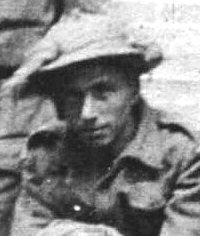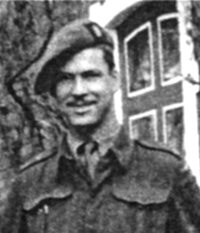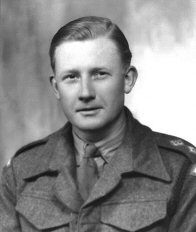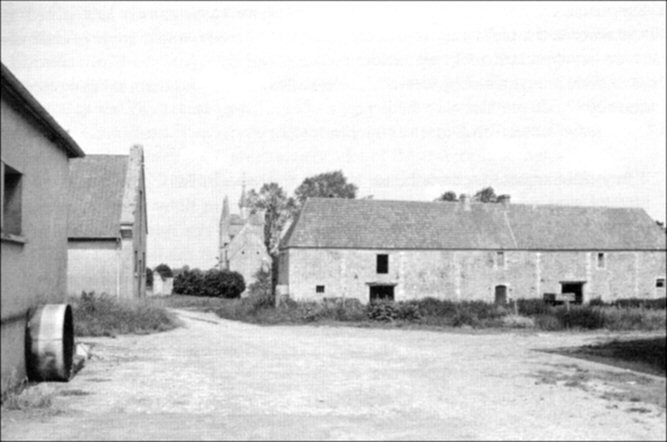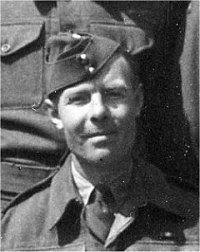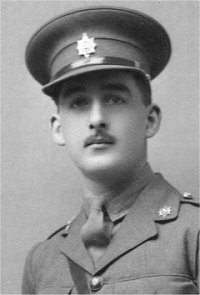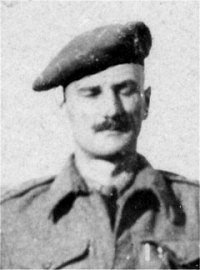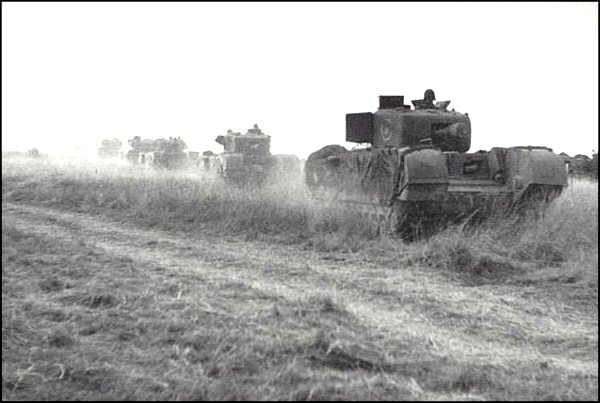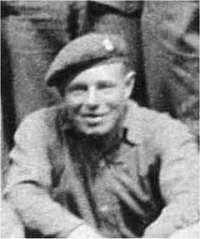1st Battalion Worcestershire Regiment - Hill 112 (July 1944)
The 43rd infantry Division war diary for the period states: "The high terrain between Odon and orne along a general line Hill 112 - St. Martin - Vieux - across from Feuguerolles sur Orne - Maltot is to be captured and held. The bridge across the Orne, if they are found undamaged, must be to secured by cover from the western bank".

43rd infantry Division planned objective area shown shaded (Hill 112 is on the far left top)
On the 3rd July 1944 the 43rd Divisional Commande and two Brigadiers visited the 1st Battalion Worcestershire Regiment positions and Observation Post (O.P.) and asked for a viewpoint of Hill 112. The Battalion had established an O.P. on the railway (shown on above map), some 1000 yards out towards the enemy positions at Carpiquet and from here Hill 112 could be seen. It was explained that this was the only viewpoint of Hill 112 and the party immediately decided to go there with a small escort. They made their reconnaissance and departed, the Corps Commander remarking on how alert and well the men of the Battalion looked.
Carpiquet, which was to the 1st Battalion Worcestershire Regiment left rear, was still held by the Germans, and held very obstinately. On the 4th July the 3rd Canadian Division attacked and a very heavy battle ensued. The aerodrome was a vast open space on which there was no cover with the Germans very cleverly dug in and concealed, with long fields of fire. Their concealment was absolutely first class. Although the Worcesters could see most of the aerodrome all the time and kept it under observation, never once was a German seen, but when the Canadians went into the attack it was soon apparent that it was in fact very strongly held. After two days of bloody fighting the Canadians won through and now covered the Worcesters left flank. During the Canandians attack the 1st Battalion Worcestershire Regiment and the 7th Somerset Light Infantry Mortar provided some support by bombarding the village of Jumeaux, this was called "Operation Stokes". The same day the Corps Commander visited the 1st Battalion Worcestershire Regiment area. Also that day 3 officers joine the Battalion from the Regimental Holding Unit (2/Lieut. L. A. Tromans, Lieut. L. A. Eberstadt and Lieut. R. S. Spicer). The following day (5th July) more officers joined the Battalion, Lieut. G. L. Revnell and two Canadian Loan Officers Lieut. J. E. O. Davies and Lieut. H. P. Fiset. Lieut. F. T. Coulcher was promoted to Acting Captain and given command of the Anti-Tank Platoon. Lieut. H. E. R. Newman was promoted to Acting Captain and became 2nd-in-Comand of 'B' Company. Captain H. R. Matthews was promoted to Acting Major and Lieut. H. S. Morrison to Acting Captain. On the 6th July 2/Lieut. C. W. D. Laughton was admitted to hospital. Preparations were also made for "Operation Bitch" which for was heavy mortar fire on known enemy localities at Jumeaux and Bretteville-sur-Odon which took place the following day, beginning at 00.15 hours. Later that evening the Worcester Battalion H.Q. position was heavily shelled at 20.30 hours, and lasted for just over an hour. Order came through that 43rd Division was to attack and capture Hill 112 and the ground beyond down to the River Orne. This hill was the highest point of a ridge of bare high ground about two miles long from right to left, and the dominating feature for very many miles around. Its particular importance to Second Army was that it overlooked Caen and the exits from there inland, so that if it were gained the enemy still holding out stubbornly in Caen would be in a difficult position. It was the first feature of any importance inland from the beaches and, from the Worcesters position at Mouen, lay about two miles ahead on the far side of the River Odon. Opposite them the valley of this river was quite heavily wooded up to about 400 yards short of the crest of Pt. 112 (later referred to as Hill 112). Over to the left in "no man’s land" as far as Verson the valley was full of high hedges and trees. The little hamlet of Miebord lay in this direction on the rising ground on the far side of the river, and further over to the left was the village of Fontaine Etoupefour, both in fairly thick country. Beyond these two places the country was completely open cornfields rising up to the long left shoulder of Hill 112. The only bridge over the Odon at this point connected Verson and Fontaine Etoupefour and was about three-quarters of a mile away to the Worcesters left front towards the enemy positions. Shortly before midnight on the 9th July 1944, 214th Infantry Brigade (of the 43rd Division) which included the 1st Battalion Worcestershire Regiment, moved forward and reached area around Fontaine Etoupefour by 4.50 hours on the 10th July. The outline of the plan was that 5th D.C.L.I. were during the night to move out and occupy the far side of the River Odon in and around the hamlet of Miebord and that, under cover of this, three crossing places of the River Odon were immediately to be constructed by the Sappers for the passage over of the tanks. 130 Brigade on the right were then, soon after first light, to attack and capture Hill 112, and 129 Brigade on the left were to capture Maltot, which lay some distance beyond Fontaine Etoupefour and beyond the left shoulder of Hill 112. Having got Maltot, that Brigade was to swing right-handed round the far side of Hill 112 and thus dominate the crossings of the River Orne beyond. 214 Brigade, less the 5th D.C.L.I., were to move forward through Miebord when the attack by the other two Brigades was under way, and get into position round about Chateau de Fontaine, in the open corn country on the left shoulder and a few hundred yards short of the crest of Hill 112. At 05.00 hrs. on the 10th July the attack started and 129 and 130 Brigades gained most of the crest for a distance of about 4000 yards after very bitter fighting. The 7th Battalion Royal Hampshires in particular suffered severely in Maltot. They got their objective but were counter-attacked when in the village, which is in a hollow, and suffered many casualties, including their commanding officer (Lieut.-Col. D. W. G. Ray) serverely wounded he was evacuated but died on his way back to England. While these Brigades were fighting to their objectives, 214 Brigade moved forward and 1st Worcestershire Regiment came into position in the area just south-west of Chateau de Fontaine. The going was difficult as many trees were down owing to the intense mortar fire and shell fire which was still persisting. However the Battalion got into position late in the afternoon and dug in. It was an awkward night as little news came through as to how the attack generally had gone, but from the noise of battle all round and the enemy fire still coming down it was pretty clear that all was not as well as it might be. |
Lieut. L. A. Eberstadt
Lieut. J. E. O. Davies
Capt. F. T. Coulcher
Major H. R. Matthews |
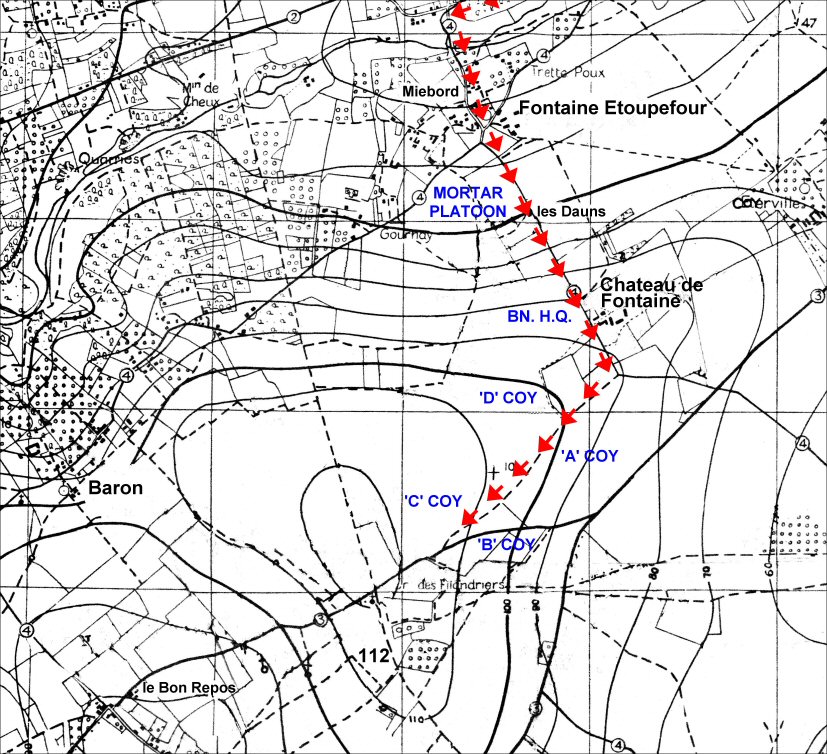
Movement and positions of the 1st Battalion Worcestershire Regiment companys on the 10th,11th and 12th July 1944
Chateau de Fontaine |
At 09.10 hours the 1st Battalion Worcestershire Regiment received orders for "Operation Jupiter" and moved forward from Mouen and by late afternoon they had dug in in cornfields to the west of Chateau de Fontaine, linking up with the 4th Battalion Wiltshire Regiment on the right. At 23.30 hours the Worcesters relieved the 4th Battalion Wiltshire Regiment at Chateau de Fontaine. The Wiltshires then moved back to a defensive position in an orchard north-east of Baron. During the take over the Worcesters were subjected to considerable tank and mortar fire. "C" and "B" Companies were forward just short of the crest of Hill 112, with patrols on it, but any movement by them brought down heavy automatic fire from enemy infantry and tanks lying back just beyond the crest. “A” and “D” companies were in rear. |
Battalion Headquarters was situated on the perimeter building of the Chateau de Fontaine and any water required had to be pumped up from the well near the stables.
Corporal W. Gould |
Corporal Bill Gould (Signals Platoon) recalls: "Grabbing a jerrican I went to replenish our supply and while in the very process of pumping, a hail of mortar bombs descended and three senior officers in consultation nearby were all killed. With the aid of a colleague I dragged the bodies into one of the stables, and in a somewhat shattered state I returned with the water. This kind of incident was merely typical around Hill 112, but we never got used to it. The tea made on this occasion was strong, and settling down to the grim routine we listened to the whine of shells and to the continuing misery of soul destroying thoughts on the utter futility of our mad occupations. Every moment we were engaged on Hill 112 were moments fraught with anxiety and our spirits sank desperately low, for the future looked bleak for those of us who were left of the original Battalion for we could not imagine that we should get out of the deadly place in one piece. 'How much longer?' was the uppermost thought in our minds. The walls which bounded the chateau had been hit so many times that for half its length it was at ground level. Time and time again I went out with assistance to repair broken communications and each and every journey was a hair-raising experience. The wireless sets which should have provided adequate links were unreliable and were constantly drifting off net (off tune) and in consequence we had to provide a line service." |
On the next day (11th July) fierce battles continued along the whole front. Towards late afternoon it was heard that the 5th D.C.L.I. were to attack with armour and capture the copse immediately on Pt. 112 (Hill 112) which the Brigade on the right had failed to achieve the day before. The attack went in an hour or so later. As history now shows it was a very gallant failure. Under Lieut.-Col. R. W. James (he had been appointed C.O. after Lieut.-Col. J. W. Atherton was killed) the 5th D.C.L.I. gained their objective but were then counter-attacked fiercely by heavy armour and infantry and, British tanks not being able to give much assistance, were shot to pieces by the opposing armour. Lieut.-Col. James was killed while directing artillery fire over the air. The evening came with the 5th D.C.L.I. almost non-existent, so that 214 Brigade were, to all intents and purposes, down to two Battalions — 1st Battalion Worcestershire Regimen and the 7th Somerset Light Infantry. Orders were received that the Worcesters were to hang on at all costs.
The following day (12th July) Major George Taylor, who was second-in-command of the Worcesters, was appointed to command the 5th D.C.L.I., a very difficult job because they had taken a terrific hammering. The fighting in the area was fierce with enemy mortar fire and the presence of many German tanks and self-propelled guns. German losses were also high. As one of the forward Battalions the Worcesters were still holding their positions. 'C' Company was on the right in standing corn and 'B' Company on the left, both within about 150 yards of the crest. 'A' and 'D' Companies were in the rear. Anti-tank guns were in Company localities as were the Carrier Platoon, dismounted. It was out of the question for them to have their carriers with them as anything above ground soon got hit and so they were left at 'A' Echelon. The Mortar Platoon, commanded by Captain Jock Bannister, was still at Les Dauns about 300 yards back. Forward Companies were so much under the nose of the enemy that it was quite impossible to get supplies to them, and accordingly they held their positions by night, moving up there just after dusk and coming out again just before dawn into two fully dug Company positions in rear of 'A' and 'D' Companies, leaving standing patrols in their forward positions. Sergt. Preece and his Assault Pioneers laid booby traps in the gap between the two forward Company positions as it was impossible to get observation of more than a few yards in the standing corn, and infiltration was a matter much to be considered. This went on for some days with active patrolling of the crest, particularly by the Worcesters snipers who had one or two very successful days. |
Major George Taylor |
The Battalion’s position here was very much in the open and this could not be avoided owing to the very nature of the ground. It was under observation from the enemy and movement of any consequence immediately brought down his fire. This was particularly so with any vehicle which tried to get up to the position by the only road through Fontaine Etoupefour. Only the bare minimum of vehicles (and these always armoured ones) came up the road, and these very slowly so as not to raise any dust.
On the Worcesters side there were constant reports of enemy forming up on the far side of the crest and also of the noise of armour on the move. Any such targets of consequence were immediately engaged by either our own mortars or the gunners. This was done on a code word as all likely F.U.P.s (Forming Up Positions) were located within a few days and allotted a code name. No actual figures are available but it is known that these shoots were highly successful and saved the Battalion from heavy counter-attack on more than one occasion.
On the night of the 12th July the 43rd Infantry Division passed from 8th Corps to 12th Corps under the command of Lieut.-General Sir Neil Ritchie and was now given the task of attacking immediately south-west of Hill 112.
Sergeant Albert Greatrix of 13 Platoon, 'C' Company, remembers arriving at the bottom of Hill 112 and digging-in and the events of the late afternoon on the 13th July 1944: Lieut. Spicer told me that he had to take over my position and that I had to take the section of men up to the top of Hill 112, which was still very much alive with German tanks and motor bikes. I managed to get about 7 men together including Private Vic Need. Lieut. Spicer then took over my slit trench, where he remained on his own. Just before we left he said to me 'If I get killed take my wrist watch and ring and any correspondence you find on me and send them back to my wife'. We then moved off slowly keeping our heads down but had only advanced about 30 yards when a shell dropped right on the slit trench and blew Lieut. Spicer to pieces. We quickly went back to try and find him but could not find anything at all, only a few bits of what remained of his boots. So sadly his wrist watch and ring never did get back to his wife. |
Sergeant Albert Greatrix |
Lieut R. S. Spicer |
There was nothing we could do so we decided to continue our patrol up Hill 112. In places the corn was shoulder high and it was very difficult to keep on our line to the top. Anyway after some time we managed to complete our mission. We then dug-in for the night. There was a road running along the top of the hill and we could hear Germans coming along on motorbikes. By first light next morning we found that some of our tanks had crept up along side us and started to blast some of the German tanks. |
|
The top of the hill was very much still in enemy hands so we decided to trace our tracks back down to report the situation to Company H.Q. and also advise them of what happened to Lieut. Spicer. It was difficult to find our way back but luckily Vic Need was a wizard at finding his way through difficult ground and we had a most unforgettable few hours returning down the hill to Company H.Q. position." Enemy mortaring continued throughout the day without respite and produced its inevitable casualties. Captain M. J. Ratcliff (H.Q. Company) was accidentally wounded in the ankle and admitted to hospital. The Canadian Loan Officer Lieut. J. M. Bennett, whose father had served in the Regiment, was hit in the stomach. Captain Shaw of 172 Field Battery, who was acting as an F.O.O. just short of the ridge, was killed also by a direct hit on his slit. |
Captain M. J. Ratcliff |
|
Lieut. J. M. Bennett
Captain Peter FritzR R. Roose |
The Worcesters Intelligence Officer (I.O.) Lieut. Roy Humphreys had a narrow escape when returning from one of the Companies when a bomb burst right alongside him. Luckily he escaped injury. Incidentally, he tried to go round every day to each Company and put them in the picture as to what was happening elsewhere.
Corporal Bill Gould (Signals Platoon) recalls: "The line communication which was vital was constantly being severed and a memorable effort to restore links with the forward Company is worth recording. Sergeant R. C. Strange had only just joined the Battalion (as Signals Sergeant) and decided to do the job himself with my assistance. I suggested that rather than mend the existing breaks it would be quicker to lay an entirely new line. He agreed, and together we set out on the most perilous journey I have ever taken. On setting out a shell blew a gaping hole in the wall of the chateau (Chateau de Fontaine) which was our headquarters and we used it to expedite our journey. By dint of a most harassing and devious journey we made the ridge and restored communication to the forward position and witnessed at first hand the devastating fire which the securely hidden German tanks were bringing down on our positions. This outpost was manned day and night and had to be supplied with all requirements, usually after dark. With what relief they were once again in touch with Battalion Headquarters, and they wished us success on our return journey. The situation was under such surveillance by the enemy that every time we raced to some sort of shelter, bullets came at us from goodness knows where. Half way back I heard a shell coming in my direction and I dived head first into an occupied trench in which a Corporal was apportioning cigarettes for his respective Platoons. They had been set up on the lip of his trench, and the shell dropped so close that every vestige of tobacco ration was blown to smithereens. Slowly recovering we laughed at each other nervously, and dragging myself out of the trench I proceeded on my way back to Battalion Headquarters. The Sergeant and myself both returned safely, but needless to say the line we had so gallantly laid was not working. Upon retracing our steps when darkness fell we found the line broken in numerous places. We had to rely in this desperate area almost entirely on wireless communication." On the 14th July Captain Peter FritzR R. Roose, who was commanding 'A' Company was wounded in the knee and had to be evacuated. |
Lieut. Roy Humphreys
Captain R. Duff-Chalmers |
The 7th Battalion Somerset Light Infantry on left of the Worcesters were unfortunate. Having lost Lieut.-Col. R. G. P. Besley (wounded) to start with, they had a new C.O. Lieut.-Col. G. C. P. Lance who was only with them for two days before he was killed. Their second-in-command, Major E. J. Bruford, then took over, but he, with the Major commanding the anti-tank battery, was killed in Chateau de Fontaine. It was extraordinary how any building or obvious feature attracted enemy fire. However every means of retaliation were employed by using artillery, mortars and medium machine guns to beat up probable enemy H.Q. (selected from the map and aerial photographs) whenever their mortaring became excessive. The 1st Worcesters carrier position also at this time was a little awkward. They were the only vehicles other than jeeps that had been up with the Battalion since the beginning, and even they seemed to get hit and brew up very easily unless they were actually dug in below ground. The jeeps were put almost entirely at the service of the Medical Officer (M.O.) Captain R. Duff-Chalmers and were fitted up to carry three stretchers. They did wonderful work.
One interesting thing is that when the 1st Battalion Worcesters first went into the position a Company locality was dug which it was later decided was unsound tactically and abandoned. This locality was rather obvious and it is surprising the amount of mortar and shell fire that it attracted, which gave added weight to the argument of having dummy positions.
At this time it was felt that if only the Brigade had really heavy armour it might have been possible to have obtained control of the crest, but British tanks seemed underarmed and under-gunned so far as their opposite numbers were concerned. The German tanks lay back some 400 or 500 yards behind the crest and if any of ours appeared over the skyline they were invariably hit and brewed up. The skyline here was unfortunately full of evidence to this effect.
Defence maps were issued almost daily showing the identity of the enemy Divisions. At one time there were three or four Panzer S.S. Divisions in this and the neighbouring sector, including the 1st S.S. Panzer Division and the 10th S.S. Panzer Division.
On the evening of the 14th/15th July the 1st Battalion Worcestershire Regiment received orders that it was to be relieved by a the 5th Battalion Dorsets and was to fall back to Bas de Mouen. This was welcome as it had been in the line without a break since Cheux, a long time for men to live in slits with little or no exercise. Spirits were high but the individual riflemen were impatient to have a go at the enemy who seemed to send over his mortar bombs unendingly and accurately. The hand-over was done in the normal way at night and without apparently being discovered by the enemy although the forward Companies were within 100 yards or so of their opposite numbers. The only incident was when Tac. Battalion H.Q. were approaching the crossing of the Odon at Miebord. The armoured truck of the acting Battery Commander, which was leading, came up against a tree which had fallen across the track, and the two jeeps with Battalion H.Q. following closed right up—it was a dark night. Immediately very heavy mortar |
Churchill tanks on Hill 112 |
fire started to come down on the group and before the acting Battery Commander could get out of his truck a bomb pitched straight inside, killing him and his driver and setting fire to the truck. It was impossible to move the jeeps but luckily no other casualties were suffered, although the bombs fell fast and furious all round for ten minutes.
Lieut. E. Tinkler |
Before leaving Hill 112 there was another interesting example of how the Germans would lie up in hiding in the Worcesters position. For days the Worcesters had been troubled with very occasional sniping but, as there was a fair amount of small arms fire most of the time, little attention was paid to it. However one day a enemy mortar hit a haystack which burst into flames, and out of the haystack tumbled a very be-draggled and shaken German rifleman. Apparently he bad been there for four or five days and was quite prepared to go on lying up there. The 1st Battalion Worcestershire Regiment remained at bas de Mouen for two days (in positions to the east of where they had been previously) and looked forward to a spell of comparative quiet, but it was not to be. The Luftwaffe started to strafe the area every night and morning. Up till then they had only appeared infrequently and done a little machine gunning, but now they started to use bombs of various sorts and sizes. In addition a certain amount of shelling and mortaring came from the direction of Hill 112 directed probably against the tanks which were continually moving backwards and forwards through the position. It was difficult at the time to understand the reason for these continual movements of very large numbers of Churchill tanks which at one time moved from right to left and then some two hours later came back again, particularly as no armoured battle came off or apparently was contemplated. It was assumed that this was part of a deception plan to lead the enemy to suppose that some armoured thrust was coming towards the south of Caen, still held by him. Lieut. E. Tinkler who was commanding the Carrier Platoon was evacuated beyond the Regimental Aid Post suffering from physical exhaustion. |
BARON — HILL 112
On the 17th July the Worcesters received orders that they were to relieve the 5th Battalion Wiltshire Regiment at Baron, at the foot of Hill 112. The Worcesters left Bas de Mouen at 16.30 hours and finally completed the relief at Baron by 20.30 hours. The 5th Battalion Wiltshires then moved back to a rest area at Mouen. The Worcesters where now to the right rear of the filling in the gap between them and the left Battalion of 53rd Division which had come up on the right. The take-over was more or less uneventful — 'D' and 'A' Companies were forward right out in the open without a stitch of cover, and 'C' and 'B' were in rear amongst hedges. The slits taken over were well constructed, in fact they were too good in that everyone had so much head cover that it was almost impossible to fight out of them. This had to be rectified. Mortars were fairly close to Battalion H.Q., which for the first time since landing found itself above ground as it took over from the other Battalion a house which they had used as a H.Q. It was well sandbagged, hidden in the trees and seemed almost too good to be true—as it later turned out.
The 1st Battalion Worcestershire Regiment was now looking a bit different both in officers and O.R.s from what they had been only three weeks earlier. They had lost seventeen officers in one way and another and sections were down to about five strong. The Companies were now commanded as follows :— 'A' Company - Major K. R. H. James; 'B' Company - Major A. A. Grubb; 'C' Company - Major M. M. Souper; 'D' Company - Major P. T. Weston; 'Support' Company - Capt. N. Watkins, and 'H.Q.' Company - C.S.M. S. Hawkeswood.
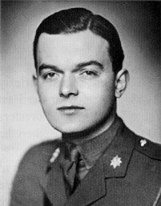 |
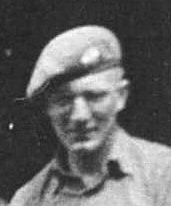 |
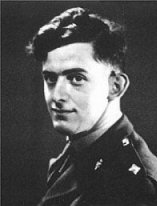 |
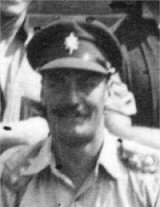 |
 |
Major K. R. H. James |
Major A. A. Grubb |
Major M. M. Souper |
Major P. T. Weston |
Capt. N. Watkins |
Hill 112 was now left alone by both sides as a scene of infantry attack. On the left of Second Army the first push through Caen was being made, and just on the right of the Worcesters was the 53rd Division and the ubiquitous 15th Division made sporadic thrusts at Esquay, all of which latter came to nothing except that it incited the enemy to warm up the reverse slope of Hill 112 where we were, in case any forming up was going on there.
The following day (18th July) Captain D. Y. Watson joined the Battalion. The Worcesters were also told that there would make another attempt made to get a footing on the far side of the crest of Hill 112, just in front of where the Battalions 'C' Company had originally been. This time it was to be a night attack and up to two Companies used. Air photographs of the ground were sent forward and 'A' and 'D' Companies warned for the attack which it was decided was to be a silent one. These photographs were studied carefully by everyone in 'A' and 'D' Companies down to 2nd i/c Sections. The start line was to be forward of the road running from Baron to Fontaine Etoupfour which the 'I' Section (intellegence) were to mark and light. 'D' Company were to be on the right with an objective a small triangular field just over the crest which, from the map, could be seen to dominate the ground the other side. 'A' Company on the left were to take a small field about 200 yards to the left of 'D' Company’s objective.
Route taken by 1st Battalion Worcester from Bas de Mouen to Baron and back (17th to 21st July 1944) |
On success 'A' were to hand over to 'D' and withdraw back over the crest so that by first light only one Company would be out in the open. 'C' Company were in reserve and 'B' not to take part in the operation. Everyone seemed quietly confident and the respective objectives could be marked by some trees sticking up over the skyline. All orders had been given and reconnaissances made when the Battalion was ordered to draw back once more to Bas de Mouen for twenty-four hours before going into the night attack. Efforts were made to get this order rescinded because a move for twenty-four hours was not worth while if it had as its object the resting of the Battalion. Advance parties had to move out, the move back had to be done extremely carefully (two Companies were out in the open although just on the Worcesters side of the crest), and when troops got back to Bas de Mouen they had to start and dig slits, get head cover, etc. By the time all this had been done and the Battalion settled down it would be time to move forward again. However, no doubt other considerations arose and the order was confirmed. |
Before leaving Baron Battalion H.Q. had a narrow escape. As has been mentioned it was in a small house—the only building more or less undamaged in the area but well tucked away from view. Suddenly there was the crack of an 88 shot and the Signal office in the house was more or less demolished. The operators were wounded and the exchange knocked all over the place. Very soon afterwards there was another crack and this time an 88 shot had arrived through the wall into the room adjoining the C.O.’s office. Sergt. Guilfoyle and L/Corpl. Knight were both wounded. The balance of Battalion H.Q evacuated to slits nearby for the short time until they left to go back to Mouen. There were many conjectures as to how it was that the house was hit twice—it could not be seen from any enemy position and therefore it was either merely a coincidence that it happened to be in the line of fire of an 88 a long way off, or they were shooting off the map, having located the place by the two wireless sets operating there although these were always kept as far away from H.Q. as possible by using remote control.
|
House used as 1st Battalion Worcestershire Regt. H.Q. at Baron |
NIGHT ATTACK ON HILL 112 "Operation Pullman"
Having spent the night (21st/22nd July) in Bas de Mouen, the Worcesters moved forward again late next afternoon (22nd July) arriving at Baron area at 20.00 hours and prepared for the night attack. The 'I' Section had laid out the tapes and, as the start line was a long way from the objective, two 'I' men went out and got into position about halfway to the objective and there shone a red light back towards the start line—one light on the right and the other on the left. The Companies formed up and went off to time and all seemed well. A line party laid a cable as the Companies moved forward but soon this was cut by enemy fire. What with this and the difficulty of the country (it was high standing corn) the line party got left behind and communication thenceforward was intermittent by 18 and 38 sets. The later happenings are difficult to reconstruct but it is clear that control was almost impossible, due undoubtedly to the fact that the start line was so far back, added to which the advance was through high standing corn on a very dark night. Finally they had to pass through a Company of another Battalion on the way. The outcome was that although Companies got to their objectives all Platoons did not arrive together with the consequence that when the enemy put in heavy counter-attacks the Worcesters were forced back.
|
1st Worcesters route back to Baron and attack on Hill 112 (night of 22nd/23rd July 1944) |
'A' Company men - Major K. R. H. James on far right (July 1944) |
Corporal Bill Gould (Signals Platoon) recalls: "The night attack finally went in and two Companies 'A' and 'D' were formed up on the start line under their Commander, Major Weston. There was a copse occupied by the enemy to the one side of Hill 112, and its occupation would afford an excellent view of the German positions if captured. Everything seemed to be going like clockwork for the first 500 yards and we had high hopes of an easy task. Leading the line party I had taken two comrades and three drums of cable, which was ample for the distance we had to travel was 1000 yards. The standing corn in the field of advance gave off a swishing sound which must have given the alert enemy ample warning of our approach. We kept very close contact with the attacking troops as in the darkness we should soon have lost contact. As the first drum ran out, according to plan, I fixed a field telephone while my two partners kept in contact with the troops. I made the joint fully secure and then proceeded along the line holding it in my hands, letting it run through my fingers till I again contacted my colleagues. The eerie, awe inspiring, retching sound of a Moaning Minnie caused me to take a hurried dive, and not more than ten yards forward the broken line dropped from my hands: one of the mortars had blown the line to pieces. Picking myself up I dropped the handset and searched around for the missing end but I had no luck. Another ‘stonk’ of mortars dropped and I was getting |
desperate. Persistence had its reward, but the cable end that I found was the one leading back to Battalion Headquarters. Adjusting the phone once again I informed the anxious Adjutant, who was desperate for news, of what had transpired. They had heard the mortars drop and knew that progress was difficult and he instructed me to persevere. 'A' Company by this time had run into an ambush and received many casualties. My own two colleagues had returned down the line when they had realised the position and reached the broken line. They had called out my name several times but I never heard them and so we were three men adrift in no mans land. When dawn broke, the line we found had been blown completely off course and had several breaks, and in the corn all around us were a number of German slit trenches with uneaten food on the parapets. These German forward posts had been well ahead of the main body in order to forestall any night attack, and so our men had run into heavy trouble. They made a disorganised retreat and consolidated around the area where the mortars had fallen."
German Panzergrenadiers watching the British advance on Hill 112 |
The 5th D.C.L.I. now under the command of Major (later Lieut.-Col) George Taylor on the Worcesters right put up a great show of force on their front to distract attention, and the artillery was called on when the enemy realized what was happening, they fired on previously arranged D.F.s (Defensive Fire) over the crest. The night was full of Verey lights used by the enemy and fighting went on till just before dawn, but we had still not got that precious crest. 'A' Company by this time had run into an ambush and received many casualties and a number of them had been taken prisoner by the Germans. German Panzergrenadiers were lying in wait for them with machine-guns. 'A' Company men of the Worcesters had little chance. LCpl B. R. (Basil) Robinson ( 'A' Company), recalls the events: "I was in command of the 2” mortar team when the enemy counter-attacked, we had no chance. I was eventually captured by the waiting Germans and taken prisoner" |

View of the top of Hill 112
Lieut. J. E. O. Davies (7 Platoon, 'A' Company) recalls two events on Hill 112; "Private J. Walton in my platoon came across a German wearing thick lens spectacles in a slit trench. His reaction was to snatch the spectacles off the German and quickly make his way back to safety. He handed me the spectacles saying that the only reason he was able to get away without being shot was that the German could not see with out his spectacles."
"During another incident whilst we were advancing on Hill 112, I bent down to look at my compass to check our bearing, as I came up again my sergeant next to me accidentally cut through my battle dress scarf with the bayonet of his rifle and grassed my cheek"
Lieut. L. A. Tromans was wounded. L/Cpl. William Denton and Private Arthur Taylor who were wounded and taken prisoner, they were both to die just a few days later and were buried by the Germans in temporary graves at Bonnemaison, about 4Km west of Aunay-sur-Odon. Corporal John Lee (who's body was never found) was also missing presumed killed. Lieut. G. L. Revnell (of the 2nd Airborne Battalion Oxford and Bucks Light Infantry) who had joined the Worcesters with reinforcements on the 5th July 1944 with, was also missing, his body was never found (He is remembered on the War Memorial at Bayeux, Panel 16, Column 1). Major Peter Weston, commanding 'D' Company was missing, he had reached his objective and was last heard and seen calling out to find one of his Platoons. He and his Company Sergeant Major Charles Southwood was also missing. A Canadian reinforcement, Lieut. H. P. Fiset, was also wounded. Casualties amongst the O.R.s (other ranks) included Sergt. Jack Dalloway ('A' Company). The Padre, Captain W. Speirs, who was most popular with all ranks, had insisted on going with the advanced R.A.P. (Regimental Aid Post) just short of the crest, and there he did his usual good job of work—he was almost a second M.O. (Medical Officer). During the morning of the 23rd July, Captain Ron Newman led a patrol right under the nose of the enemy on the crest in an endeavour to trace Major Weston but could find nothing. The bodies of Major Weston and C.S.M. Charles Southwood were both found several days later (27th July) at the top of Hill 112, just over the crest. They had both been shot at close range by German machine gun fire. They were buried next to each other in temporary graves on Hill 112 (After the war they were re-buried at Banneville-La-Campagne War Cemetery). During the day the Battalion was back to Bas de Mouen for the last time, and there is no doubt that the men felt the loss of Major Weston. After twenty-four hours (on the 23rd July) the order came through that the Division were moving out of the line to a rest area at Jerusalem, some eight kilometres south of Bayeux on the road from there to Tilly. Companies moved independently by march route and so said good-bye to the part of Normandy they had got to know so well, leaving behind many friends, and many memories of friendships forged and jobs well done. |
Captain W. Speirs
Captain Ron Newman |

Temporary graves of Major P. T. Weston and C.Q.M.S. Charles Southwood at the top of Hill 112 where they died

Temporary grave of L/Cpl. William Denton and Private Arthur Tayor at at Bonnemaison, France (about 4Km west of Aunay-sur-Odon)

Reunion of 1st Battalion Worcestershire Regiment veterans at Hill 112 (July 1994)
Back standing L to R: Sgt. Jim Norton, Private John Bullock, George Wilkinson, Keith Thomson, John King, Alan Hitchcock, Horace Trim
Front kneeling L to R: Cpl. Bill Gould, Rev. W. Spiers, Frank Nyland, Charles Priest, Alan Buttle

